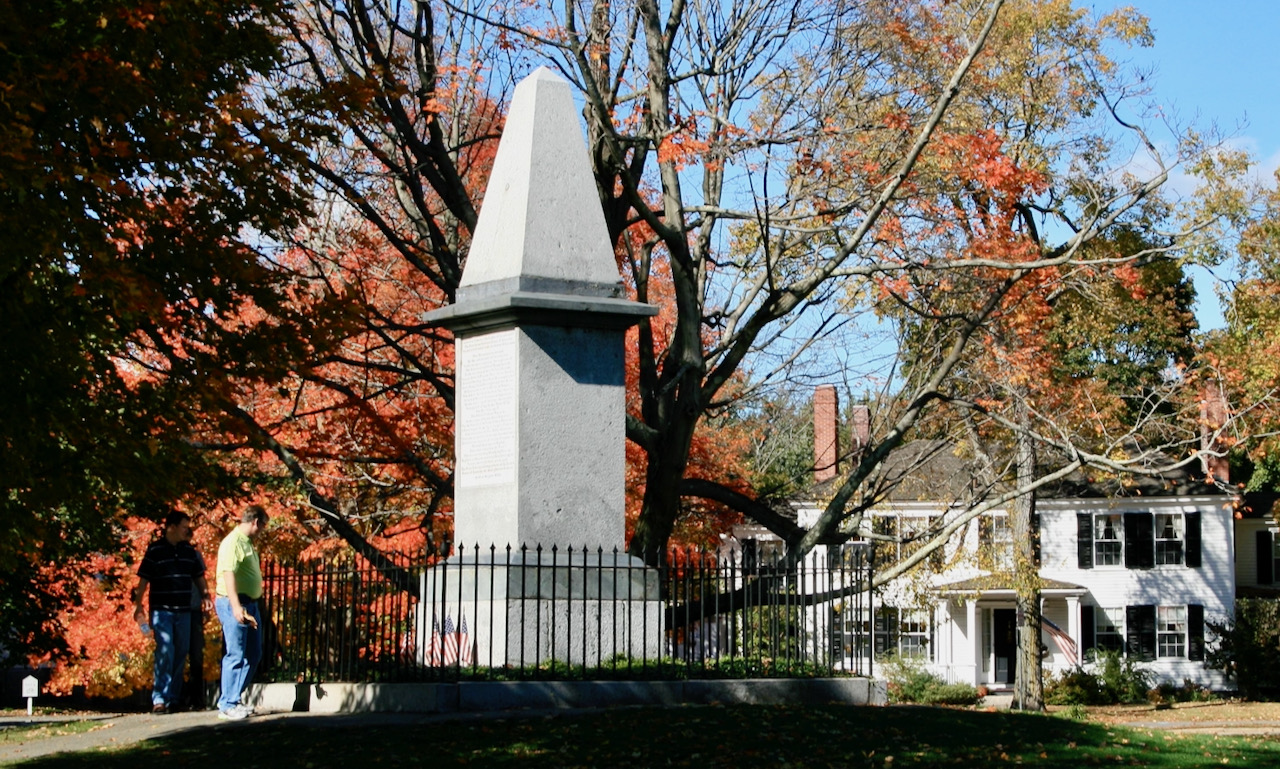Erected on July 4, 1799, Lexington‘s Revolutionary War Monument is the oldest war memorial in the United States. Featuring a granite obelisk set on a simple pedestal, it marks the approximate location of the line of the Lexington militia that stretched across the Green to confront the British Regulars on April 19, 1775.
Funded by the Commonwealth of Massachusetts following a petition to the General Court in 1797 by Joseph Simonds “to preserve to posterity a record of the first effort made by the people of America for the establishment of their freedom and independence,” [1] it was designed by Thomas Park, a highly skilled stone cutter at a cost of $400.00.
Jonas Clarke, minister to Lexington from 1752 to 1805, composed the monument’s inscription honoring the eight men who died on Lexington Green. On April 20, 1835, the 60th anniversary of the Battles of Concord and Lexington, seven of the eight men honored on the monument were exhumed from Lexington’s Old Burying Ground and reinterred in a tomb beneath the monument in an elaborate ceremony with full military honors.
As reported in the Boston Daily Advertiser on the that same day, the ceremony began at 3AM, the time when British troops fired on the Lexington militia with an eight-gun salute, honoring the eight men who “first fell as martyrs in the cause of civil liberty.” At sunrise a thirteen-gun salute honored the Thirteen Colonies (later States) followed at eleven with a procession, accompanied with military escort to the burying ground to receive the remains of those killed on April 19, 1775.
A service took place at the meeting house, then another procession made its way to the monument. In what the Advertiser described as an ‘interesting circumstance’ connected with the rededication service, ten of the eleven survivors of the battle were in attendance. Despite inclement weather, the ceremony attracted a crowd of nearly one thousand people who listened to a two-hour address, by the Honorable Edward Everett, in “breathless silence.” At the time a new marble tablet was installed in the face of the monument as well as an iron fence which surrounds it to this day.
The inscription reads:
Sacred to Liberty & the Rights of mankind!!!
The Freedom & Independence of America,
Sealed & defended with the blood of her sons.
This Monument is erected
By the inhabitants of Lexington,
Under the patronage & at the expence [sic] of
The Commonwealth of Massachusetts,
To the memory of their Fellow Citizens,
Ensign Robert Munroe, Mess. Jonas Parker,
Samuel Hadley, Jonathan Harrington Jun.
Isaac Muzzy, Caleb Harrington and John Brown
Of Lexington & Asahel Porter of Woburn,
Who fell on this field, the first Victims to the
Sword of British Tyranny & Oppression,
On the morning of the ever memorable
Nineteenth of April, An. Dom. 1775.
The Die was east!!!
The Blood of these Martyrs,
In the cause of God & their Country,
Was the Cement of the Union of these States, then
Colonies; & gave the spring to the spirit. Firmness
And resolution of their Fellow Citizens.
They rose as one man to revenge their brethren’s
Blood and at the point of the sword to assert &
Defend their native Rights.
They nobly dar’d to be free!!
The contest was long, blood & affecting
Righteous Heaven approved the solemn appeal;
Victory crowned their arms; and
The Peace, Liberty & Independence of the United
States of America, was their glorious Reward.
Built in the year 1799.
[1] Hudson, Charles. History of the Town of Lexington from its first settlement to 1868 (Revised and Continued to 1912 by the Lexington Historical Society). Boston: Houghton Mifflin Company, 1913, vol. 1.


